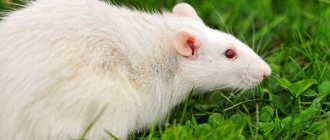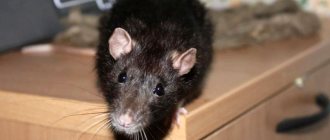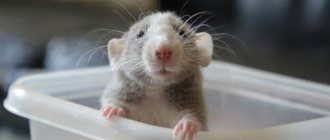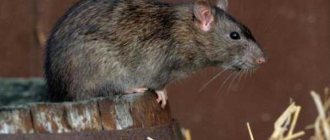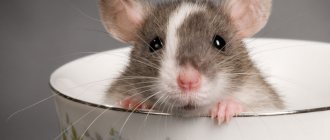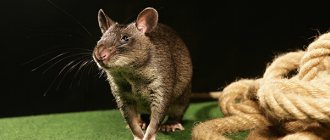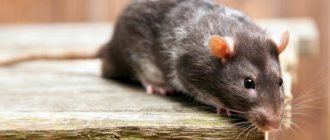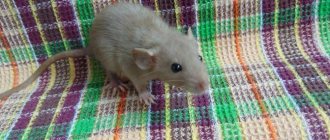Origin
The white rat is an albino form of the gray domestic rat (pasyuk). White albino rats began to be bred at the beginning of the last century in laboratories for scientific experiments. This line of albino laboratory rats gave rise to many other laboratory rat lines (not just albino ones). It is believed that the first ornamental tame rats were obtained from this line by crossing with gray rats. From the white rat, animals were obtained that were black, brown, cinnamon, cream, sepia, silver, and blue.
White lab rats have been bred to have different characteristics: some have special behaviors, such as eating rats that dance; others are distinguished by their coat - long-haired, with a crest (capuchins) and curly hair.
Currently, rats are bred in large numbers in special nurseries and used for various scientific experiments. White rats have a similar genome to humans - the same set of 46 chromosomes. Therefore, white rats are widely used for research in genetics, microbiology, virology, toxicology, and radiobiology.
The results of experiments that scientists share with the general public indicate the extraordinary mental abilities of white rats. White rats are able to sympathize and empathize with other individuals; there are known cases of altruism among white rats.
Appearance
What does a white rat with red eyes look like? This is a medium-sized rodent. The pet's weight can reach 500 grams. On average, rats weigh 300-400 grams. Males are larger than their mates.
Rats have white fur and red eyes. The muzzle is elongated and sharp, with four long and sharp teeth. Two up, two down.
Another feature of the rat is its long tail. At first glance, he appears to be bald. This is wrong. The rodent's tail is covered with barely noticeable white fibers. They are almost impossible to see.
Description
Rats have an oval body shape and a stocky build, characteristic of most rodents. The body length of an adult rat ranges from 8 to 30 cm (depending on the species), the weight of the rat varies from 37 g to 420 g (individual gray rats can weigh up to 500 grams).
The rat's muzzle is elongated and pointed, its eyes and ears are small. The tail of most species is practically naked, covered with sparse hairs and ring scales. The black rat's tail is covered with thick fur. The length of the tail of most species is equal to the size of the body or even exceeds it (but there are also short-tailed rats).
The rodent's jaws contain 2 pairs of elongated incisors. Rat molars grow in dense rows and are designed for grinding food. Between the incisors and molars there is a diastema - an area of the jaw where teeth do not grow. Despite the fact that rats are omnivores, they are distinguished from predators by the absence of fangs. Animals' incisors need constant grinding, otherwise the rat simply will not be able to close its mouth. This feature is due to the absence of roots and the continuous growth of the incisors throughout the life of the animal. The front of the incisors are covered with hard enamel, but there is no enamel layer at the back, so the surface of the incisors is ground unevenly and takes on a characteristic shape reminiscent of a chisel. The teeth of rats are extremely strong and can easily gnaw through brick, concrete, hard metals and alloys, although they were originally intended by nature to eat plant foods.
Rats have poorly developed calluses on their paws, which are necessary for rodents to climb, but the functional deficiency is compensated by mobile fingers. Therefore, rats are capable of leading not only a terrestrial, but also a semi-arboreal lifestyle, climbing trees and making nests in abandoned hollows.
Rats are very active and resilient animals, they run well: in case of danger, the animal reaches speeds of up to 10 km/h, overcoming obstacles up to 1 meter high. A rat's daily exercise ranges from 8 to 17 km.
Rats swim and dive well, catch fish and can continuously stay in water for more than 3 days without harm to their health. Rats' vision is poor and has a small viewing angle (only 16 degrees), which forces the animals to constantly turn their heads. Rodents perceive the world around them in shades of gray, and the color red represents complete darkness for them.
Hearing and smell function well: rats perceive sounds with a frequency of up to 40 kHz (for comparison: humans up to 20 kHz), and detect odors at short distances. But rats tolerate the effects of radiation very well (up to 300 roentgens/hour).
The lifespan of a rat in the wild depends on the species: gray rats live about 1.5 years, rare specimens can live up to 3 years, black rats live no more than a year. In laboratory conditions, the life of a rodent increases by 2 times. According to the Guinness Book of Records, the oldest rat was 7 years and 8 months old at the time of death.
What should a house be like?
An albino's cage is where he will spend most of his life. It, like a person’s home, should be divided into sectors. In his home, the albino will eat, retire and rest, go to the toilet and be active.
Litter
The fairly common option of using newspapers and other paper is undesirable. Albinos tend to test the surrounding objects “by tooth”, and printing ink will not be useful for them.
At the same time, white hamsters with red eyes may be allergic to wood dust, so using clean, soft, dye-free wipes may be a solution. Hay is a good choice for bedding; some hamsters even make it their treat.
A common and convenient option is sawdust (it is important to ensure that there are no sharp chips or debris in them). Not only are they not harmful to an albino, but they also absorb moisture and odors.
Cleanliness in the cage is important, first of all, for the pet itself. Wood filler is one of the most popular and environmentally friendly options - it holds odors for up to two weeks.
A convenient but expensive material is corn filler. It absorbs liquids as much as possible and maintains an excellent appearance.
Various fibrous bedding materials are contraindicated - most often cotton wool and fabrics. They can get into the cheek pouches of an albino, begin to rot and lead to inflammation. Threads are often wrapped around hamsters' paws - this can result in the loss of limbs.
All litter changes as it gets dirty. The toilet area is cleaned daily.
Different containers for food and water
To prevent the albino from turning over the bowl of water, you can purchase a special drinking bowl that is attached to the bars of the cage. The owner of the animal needs to carefully monitor its serviceability and filling.
It is necessary to clean containers for food and water without using chemicals - soda or tooth powder will do.
Character and lifestyle of the white rat
- Cat claw attachments
- Dog
- Long-eared cats
- Cat meowing
- Alexandrian parrot
- Why does a cat need a mustache?
These funny decorative animals have their own manners and habits. It is very interesting to observe them, from which you can get many pleasant and funny moments. Rats can get used to a set schedule in a matter of days. Young, newly acquired individuals can sleep during the day and stay awake at night. But over time, they adjust to the same rhythm of life as their owners and feel great about it.
These are fairly quiet creatures. They are too smart and have enviable intelligence. They are distinguished by excellent memory and ideal cleanliness, unlike other creatures similar to themselves. Rats are easy to tame. The older they get, the more sentimental they become. They can climb onto their owner’s lap and allow them to endlessly stroke their back and behind their ears. Many owners of these animals claim that they cope with stress relief just as well as cats.
Many of the rats initially remember their name and always respond to it. If you work with them, rats are able to carry out some simple commands from their owner.
This is not a dog that needs constant walks. But the rat is happy to take a walk on his owner’s shoulder or go on a visit. The main thing is that it is not too cold outside.
They are not shy, but in a situation that is unfamiliar and incomprehensible to them, they prefer to hide in the pocket or under the collar of their owner. The animal can roam freely around the room. But do not forget about precautions and keep an eye on your pet.
These are social animals. The company of people and their own kind means a lot to them. They love to be caressed; they simply need it. Without certain activities, the animal can get bored, so they simply need various devices in the cage in the form of ladders and ropes.
If the owner has little free time left to communicate with his pet, then it is better to initially get two rats, which must be introduced immediately, otherwise conflicts are possible between them. It is desirable that the rats be same-sex, otherwise, due to the high fertility of these individuals, you can quickly become the owner of a large rat family. Domestic rats resemble small children in their entire nature.
They, like babies, need constant attention and education. Much depends on a careful and attentive attitude towards them initially. So, as paradoxical as it may sound, a domestic rat needs education. the big white rat will behave
If the animal is well-fed and the owner spends a sufficient amount of time with it, it will be difficult to find a more affectionate, gentle and active creature at the same time. Otherwise, if they are mistreated, rats become angry, timid and biting.
Attitude towards a person
The decorative albino rat is a tame and loving animal. He is trainable, cunning and intelligent. Many owners claim that the rat quickly learns to open the lock on the cage. She thinks quickly, and is significantly different from her dark brothers. Watching your pet play is a pleasure. The Internet is full of videos where albinos willingly perform various tricks, climb around the room, and simply live.
A kind and gentle rat loves its owner. I’m ready to spend whole days on my hands, knees, or in my pocket. Having settled comfortably on a person, she shows her affection with all her appearance. She climbs into her arms to be stroked on her back.
Regular communication with your pet can be turned into training. The rat quickly remembers its name and the names of its cage neighbors. It is better to train animals to communicate with other pets gradually and carefully.
Night rumble
Don't expect your rat to follow the same schedule and rhythm of life as you. On the contrary, be prepared for the fact that the rat is active at night and sleeps during the day. The period after dinner is a great time to socialize and play with your pet. The attempt can be resumed early in the morning - whatever is more convenient for you. You may also enjoy the funny positions in which rats like to sleep - lounging on their backs, curled up into a tight ball, etc.
Scavenger Hunters
Rats have a habit of picking up and dragging to a secluded place something that might be suitable for playing or chewing. Rats steal and drag objects made of wood, plastic and rubber into their lair. They are happy to carry objects made of paper or fabric. Rats are also great masters at arranging all kinds of stashes and food supplies.
Fighting boxers
Not only kangaroos have shown themselves to be boxing fans! Rats also love to box - they stand on their hind legs and heartily begin to kick each other with their front legs. But this is not for fun: two rats find out which of them is the alpha male, the dominant male. Rats have a very developed social hierarchy. Sometimes you can see how, instead of a desperate fight, rats stand up frozen nose to nose. They may not get up - rodents have many different variations on this theme.
Rat bites
If a rat bites or licks you, perhaps this is his way of showing his love.
Rats also have a wonderful sense of smell, and may well bite you if you carelessly took something edible before entering the cage. Before working with a rat (and also after), wash your hands thoroughly with soap and water.
Teeth grinding
This phenomenon usually accompanies the bulging of the eyes described above. There is no need to be scared, the rat belongs to the rodent family, and its teeth are constantly growing. When a rat grinds its teeth, it tries, so to speak, to moderate their growth, to make sure that they do not grow too quickly. Moreover, teeth grinding in rats is similar to purring in cats - this is what they do in moments of relaxation and peace. This creates vibrations that help the eyeball protrude - therefore these two phenomena are interconnected
At the same time, a rat may grind its teeth when it is scared or in pain, so pay attention to the circumstances under which this happens (for example, when you pet it or vacuum near the cage).
White rat and communication with people
Rats are social creatures that enjoy interaction with both other rats and people. Decorative rats can be easily tamed, walk around the room or ride with the owner around the apartment sitting on his shoulder, the latter is a rather dangerous activity, because the rat can fall and break. Such taming should begin at an early age, and the rat should be rewarded for its courage with goodies, so they will quickly get used to communicating with humans.
Many people like to let their rats wander around the room without their attention; this is very dangerous, because a rat is a rodent that may inadvertently try to bite through the cable or eat something harmful.
A little history
Cute, affectionate and tame decorative rats are descended from ordinary wild gray rats, which cause a feeling of disgust in humans, as well as a certain fear. This is not at all surprising, since wild rats have gained notoriety not only for their behavior, but also for their ability to spread various viruses and infections.
The Chinese and Indians first became aware of wild rats several thousand years ago. In the 16th century, as maritime trade developed, rats spread throughout the world, moving from continent to continent. In the 19th century in England, these rodents began to be used in battles against dogs, after catching them. During the same period, some hobbyists began breeding rats, especially tame, white ones. Such tame rodents were shown at exhibitions; in addition, white rats took part in circus performances. Some pet lovers started keeping rodents in their homes because they did not pose any danger to humans.
Some of the individuals were used as experimental animals in various laboratories, which is still practiced today, and some of them moved into the homes of scientists. Scientists saw in rats animals that are quite intelligent and attached to humans. Thanks to the crossing of laboratory rats with wild animals, new species and breeds of domestic decorative rodents have appeared, which can still be found among various breeders.
Keeping rats at home
Rats are quite large animals and very mobile, so tiny cages are absolutely not suitable for them. The minimum cage size for a pair of rats is 40x30x50, it is advisable to purchase a larger cage.
The cage must contain:
- filler , optimally - dry wood granules, it is economically consumed, perfectly absorbs moisture and odor, and cannot in any way injure the rat, unlike sawdust and hay;
- a house for privacy where the rat can sleep or just relax from the outside world;
- tunnels and ladders - rats are very active and love to play, the owner must provide them with the opportunity to entertain themselves;
- mineral stone for rodents;
- drinking bowl for rodents;
- feeder fixed to the shelf .
Under no circumstances should filler made from coniferous trees be used. This leads to illness and increased mortality in pets.
You can also add various hammocks, toys for rodents and other little things to the cage that will please your pet, such as vitamin sticks that are fixed to the bars of the cage.
Do hamsters bite?
This question interests most breeders, since the animal is often purchased for a child. Any hamster can bite, regardless of whether it is white or not.
Campbell's hamsters are considered the most aggressive, so you need to wear special gloves when playing and handling them. Syrians have a friendly disposition. They do not show aggression, are willing to be held, and love to play with children.
Djungarian hamsters show aggression towards their relatives and can even bite humans. This is due to the manifestation of dissatisfaction, defense of territory, or the painful condition of the pet. Even the calmest pet can bite a person.
Albinism is a mutation caused by the lack of melanin pigment in the skin, fur and iris of the eyes. Hamsters of any breed can be albinos. For quality care of white rodents, it is necessary to take into account the characteristics of their body.
Hamsters are very special pets. There are more than 20 breeds of hamsters, but no more than 5 main species are kept as pets. Below is a list of the most common types of hamsters with photographs.
Feeding
The main diet of a decorative rat consists of cereals and cereals; they also eat well succulent foods such as apples, carrots, grapes, bananas, in general, almost all fruits and vegetables.
There is a stereotype that rats are omnivores, but this is not true. It is not recommended to give rats salty, sweet, fatty, fried, carbonated foods. The rat itself will not sort out what it can and cannot do; just like a person, it is guided by the concepts of “tasty - tasteless.” Few people know, but rats love insects very much, I offered them Zophobas larvae, marbled cockroaches, Turkmen cockroaches, rats eat them as a favorite treat, regardless of whether they are hungry or not.
Simple wire cutters
The most primitive device is very similar to ordinary scissors. Only one of its cutting surfaces is equipped with a small notch with a sharp edge. Using such a device is easy, provided you have some skill and experience. For young dogs, nail trimming is always stressful. They do not want to sit quietly, they strive to tear the paw out of the owner’s hands and in every possible way complicate the process. So Litbro.ru will not recommend such a gadget to novice dog breeders. The risk of causing serious physical injury to your pet is too great. Well, for experienced owners who have used similar tools more than once, nothing better can be desired. Cheap and very effective.
Cost – 35 – 72 rubles.
More advanced versions of hand cutters offer expanded functionality.
Although their main part, in the old fashioned way, is based on two cutting surfaces. Service additions imply only human convenience. Models with rounded ends, a container for cut claws and lighting have proven themselves very well. The fact is that some dogs have the habit of looking for clipped ends on the floor and eating them. Sharp, bent cuttings can damage the stomach wall and cause bleeding. A small “waste collection” effectively solves this problem.
Price – 636 rub.
Another gadget from the line of simple nippers has comfortable ergonomic handles that allow you to securely hold the tool while trimming nails.
This is important when the animal gets nervous and breaks out.
We pay attention to one more detail - the expansion spring. It fixes the cutting surfaces in the open state, which makes the operation somewhat easier.
Otherwise, the functions of the device duplicate all the features of its predecessors. To properly shorten claws, you must have the skill and achieve unquestioning obedience from your dog or cat.
Cost – 229.93 rubles.
How to bathe a rat?
Rats are pretty neat creatures. Apart from some males. And yet, to the question “is it possible to bathe a rat?”, the answer will be “you can, but not often.”
For decorative rats who are afraid of drafts, hypothermia, overheating, new situations, in any case, this will be stressful. And in rats it leads to weakened immunity and possible diseases.
Therefore, it is easier to list the cases when you need to bathe rats and when you shouldn’t. It is necessary if the rat gets dirty in something inedible. She will try to cleanse herself and may poison herself. If the rat's tail is dirty, or it smells bad due to being in dirty bedding for a long time. If the rat is old and no longer takes good care of itself, as well as in cases where it is necessary to get rid of parasites.
You cannot bathe a rat if it is sneezing and has wounds on its body. And also, if the rat only dirty its paws and tail, it is enough to wash only these parts of the body. How to wash a rat at home? No fuss or rush. Domestic rats are very shy and do not tolerate any changes in their lives well. All actions must be measured and calm. To do this, you will need a shallow container, however, quite large so that the rat does not feel crowded there, and it can stand on all four paws without plunging its whole body into the water.
First you need to wet the fur and then apply a specialized shampoo designed for washing rats. As a last resort, it could be baby shampoo. Here you need to make sure that the rat does not scratch its owner, and water does not get into its eyes and ears. You need to dry the rat in several towels so that drafts do not disturb it. And return it to the cage with other rats with caution. These animals recognize each other by smell. A changed smell can lead to aggression from relatives.
How long do albinos live?
Albino rats get sick quite often. They have a very weak immune system, so even a common cold can lead to the death of the animal. Often representatives of this breed die at the age of 1.5-2 years. While the life expectancy of rats of other varieties is 3-3.5 years.
However, owners of albinos can still extend the life of their pet. To do this, you need to take care of the furry’s health - organize proper nutrition, protect the cage from cold and drafts, and maintain cleanliness in the animal’s home.
Also, at the slightest manifestation of painful symptoms, you should immediately take the rat to the veterinarian. If the above conditions are met, you can safely extend the life of an albino to 3 years.
Rat breeding
Puberty in rats occurs in the fifth week of life. They can multiply rapidly and uncontrollably. Therefore, novice breeders are advised not to place rats of different sexes in one cage, but to have two animals of the same sex, breeding only consciously.
The female comes into heat every five days all year round, so even adults who accidentally end up in the same cage are able to have time to create offspring. Moreover, sometimes the actions of a particularly persistent male can provoke a female into estrus. A rat's heat can be recognized by its special behavior. When you stroke her back, she “dances” and her ears twitch slightly.
How long does pregnancy last in rats? Pregnancy in a rat lasts only 21-26 days. The belly becomes visible in the second week. So, before having offspring, you should take care of new owners for the little rats.
How many rat pups are born at one time? Depends on the age of the female and her breed. On average there can be up to 11 baby rats. True, a sphinx can give birth to twenty. The older the female, the fewer children she will have. It should be noted here that the first birth should occur at 4-5 months of life. If by 6 months she has not yet become pregnant, it is better not to let her mate, otherwise this could lead to complications during pregnancy and childbirth. A caesarean section may be necessary.
The rat gave birth. What to do? You need to prepare for this in advance. First, provide your pregnant rat with good nutrition and exercise. Secondly, provide her with materials to build a nest where her children will be born. Third, remove the male from the cage. It will not cause harm, but a few hours after birth, the rat may become pregnant again. And she needs rest, both physical and moral. The rat must feed its babies.
Spreading
This small animal lives in the forest zone and mountain forest belt of the European part of the countries of the former Soviet Union and Western Europe. The habitat extends to the north, right up to the coast of the Baltic countries and the Karelian Isthmus. Then the northern border passes through the Kalinin, Gorky and Novgorod regions, Tatarstan. In the southwestern regions of the Odessa region and in the south of the Carpathians, the border of the range runs along the right bank of the Dnieper, through Donetsk, Zaporozhye, Lugansk and a little north of Volgograd it reaches the Volga. Along the right bank it goes up to Saratov and smoothly flows to the left bank to the forest-steppe regions of the Volga region.
The yellow-necked mouse, a photo of which we posted in this article, lives in the forests of the Caucasus, Crimea, and the lower reaches of the Sudak and Terek rivers.
Diseases
Common ailments in pets:
- Problems with teeth, their excessive growth. Sometimes, due to overgrown teeth, the animal cannot eat or even close its jaws.
- Mycoplasma infection.
- Allergies.
- Suppuration and skin problems.
- Infection with parasites (infection with ticks is especially common).
Only a veterinarian or a rodent specialist - a ratologist - should treat animals, because these pets react very sensitively to any medications, and errors in dosage can be fatal. In addition, due to the rapid metabolism, the disease can overcome an animal faster than a larger pet. Decorative rats and mice are easy to care for and maintain; they easily and happily interact with people, so it is not surprising that these rodents are gaining more and more popularity as pets.
Hygiene
The pet's fur and claws require special attention from the owner. The animal performs basic hygiene procedures itself. This is a very clean animal. You can often see a rodent washing itself.
Brush the fur of the red-eyed albino with a soft-bristled toothbrush. Animals love this procedure very much if it does not cause them pain. If you notice yellowish spots on the fur, you should contact your veterinarian, as this may be a sign of some disease. In case of severe contamination, the animal can be washed in a deep bowl, but you need to be prepared for the fact that the rat is unlikely to like the procedure.
If the animal does not grind its claws down on its own, then they have to be trimmed. This is necessary so that the fingertips do not suffer. For this manipulation, special nail clippers or nail clippers are used. The procedure is simple and does not cause pain to the rat.
Taming and training your pet
The first thing you need when training is a treat. As a treat, you can use a sunflower seed or a small piece of meat (eggs); you cannot use sweets. The first step is to gain the animal's trust in you. There are very sociable individuals who are happy to communicate with the owner, however, there are those who have difficulty making contact.
A rat can be trained to:
- Accustom to a nickname;
- Train to come running when you call;
- Train yourself to stand on your hind legs;
- Teach him to return to the cage at a certain time or at your request;
- Build her a mini-town and teach her to run up the stairs;
- Any simple tricks you can think of.
When giving a treat, say your pet's name. The nickname should be simple and sonorous, so it is better perceived by the animal; after all, these are not people and memorizing long phrases is not typical for them. After a while, at the sound of your voice, the pet will begin to wake up and run towards you. If you are completely confident in your animal, you can let it walk around the apartment. From time to time you need to call him and treat him with a treat, otherwise one day you will have to catch him throughout the apartment, and this is very difficult, due to the fact that rats are very nimble. Train your rat to return to the cage. To do this, pour out the food, call your pet, and tap the bowl at the same time.
When training a rat, you must remember its safety; it is advisable not to leave it alone in the free range, it can run wild, chew wires or fall somewhere. A rat is not a dog, it will take a lot of time and effort to teach it something, if you do not have a reserve of patience, then it is better not to start.
Why does a hamster have red eyes?
If we talk about albino hamsters, the red or pinkish color of the eyes of these animals is considered the norm and is due to the absence of the melanin pigment, which is responsible for the color of the fur and the iris of the eye. In rodents, whose body does not produce melanin, the coat has no color, and therefore is snow-white, and the eyes have a bright red tint, since their membrane is transparent and blood vessels are visible through it.
But sometimes it happens that the eyes of a small pet that is not an albino acquire an unhealthy reddish color. Why does this happen and what treatment methods can be used to help your furry pet?
Blindness
Red eyes are characteristic of rodents suffering from congenital or acquired blindness. It is not difficult to identify a hamster that is blind from birth: the baby hardly moves, does not react to movements and does not frolic with its fellows.
A healthy animal can go blind due to injury or infection in the eye. If the owner notices that the pet's iris has become red and pus is oozing from it, you should consult a veterinarian and not allow the disease to develop, which can lead to complete blindness.
Dust irritation
The cause of redness can be dust that gets into the rodent's eyes. This often happens when the hamster is allowed to roam freely throughout the apartment. In this case, it is necessary to rinse your pet's eyes with a weak solution of potassium permanganate or chamomile decoction.
Infection
Also, redness in a hamster's eyes can be caused by an infection. This happens especially often if the owner forgets to change the bedding in the rodent’s cage and does not thoroughly clean it. A frivolous attitude towards your pet’s health can provoke the development of conjunctivitis, and then long-term complex treatment will be required.
If the animal's eyes are red and purulent discharge is oozing from them, you should not try to cure the pet yourself. You especially shouldn’t put drops intended for humans into your hamster’s eyes. Only a qualified specialist can prescribe appropriate treatment and help the animal cope with the disease.
Owner reviews
CoeEkaterina
At the end of May we got ourselves a little friend - a decorative rat. They named him Stephen. He is a white, handsome boy with a bald tail. Initially, we did not have a cage; Stephen lived in a box. So, this is the worst idea. He happily gnawed at the box, ran away and traveled around the apartment. We bought a cage. Now he loves his house more than anything.
The cage cost about 600 rubles. It has three floors. We put the filler down, where the pet can safely perform its intimate affairs. The second floor used to be empty, but now there is something like a covered hammock hanging. The third floor is now empty. There used to be a house, but after a while the little rat began to get stuck in the house. I had to remove it.
We buy any food for rodents. Special sticks that rats love to chew. In addition to special food, we also give bread, meat (not raw), and fruit. In principle, rats are not picky eaters. With us, Steve eats everything he can see. Quite a calm animal. But we have a little rat coward. He is afraid to leave his house, if you let him go for a walk, for example, on the table, he will take a walk, but he is afraid to eat in the wild.
You shouldn't leave things near the cage; we successfully chewed two T-shirts and one book. We don't leave things around anymore. Even if it seems to you that the little thing is far away and he won’t reach it, then you are wrong. Somehow, miraculously, they will get everything through the bars :)
Teaching a rat some commands is quite difficult, but quite possible. We are now trying to rid the baby of fear. As I said above, she is afraid to be outside her home. Next we will teach some basic commands.
Is it worth buying a rat? If you don't like animals, don't buy. And of course, if you are too lazy to often change the litter, wash your pet and care for it, then not only should you not buy a rat, but any other animal too.
arth
I had both hamsters and mice. But I was drawn to heavier artillery.
I went to the nearest pet store and bought an ordinary white rat (female, about 5 months old). Classic, white fur, red eyes, pink paws and a tail barely covered with fur, I had to call her Lariska.
She put her in a small cage in which a hamster had previously lived, and soon went to buy a new one, the rat had no place to turn around! A couple of weeks later, I bought her a friend (who, by the way, is her sister), at first they fought and sorted things out in a very funny way, but then they became friends and began to sleep together and play, only sometimes they took food from each other.
And a couple of weeks later, the second rat gave birth to 11 baby rats, 10 alive and 1 dead! (I knew I was buying a pregnant one). And I was amazed at how good and responsible mothers rats are! She gathered everyone in a heap under her and fed them, washed and cleaned them, built a nest for them when she felt danger, and dragged each one to a new place. Very cute. The rat babies grew up very quickly, and I had to give them away, I kept one for myself, the little rat was born of the Dumbo breed.
bird777
My love for rats began with the very first black and white rat, Felix, whom I bought at the market as a little rat. He immediately captivated me because he didn’t bite at all; before I had rats, I had hamsters, and I came across very biting ones that were even impossible to tame.
Rats will not sit on your hands for a long time, they are twisted, they always need to move and run somewhere. That's why a cage needs a wheel. But preferably something completely metal, otherwise they will chew the plastic one, as happened with us.
Food: I bought wheat, corn, barley, peas, seeds, rye at the market where they sell food for domestic chickens, mixed everything, and I got the main food for rats. In the summer she brought them green grass. Be sure to bring twigs from trees all year round; they need something to chew on to wear down their teeth.
In general, they eat everything. It goes without saying that they cannot have any “human” food, especially fried or boiled food. But sometimes we still couldn’t resist pampering them with a cookie or a piece of bread. They also sometimes gave us bones from chicken legs; the rats simply adore them and eat almost the entire bone. They also like cucumbers, various fruits, and boiled eggs.
The main disadvantage of rats is their unpleasant odor. It was heard even from one little rat, and when I had 9 of them, I had to clean the cages every day. But in principle, it’s not difficult to just change the bedding in the cage every day, especially if you have 1-2 rats and you clean it every day, there won’t be an unpleasant smell in the house. At first I used sawdust. Then I tried hay, but the smell from the hay became simply hellish, I quickly abandoned this idea.
The best option turned out to be mixing wood cat litter with sawdust, as this will reduce the smell.
You can also bathe the rats, then they will smell even less. We simply filled the bathtub with water and let them swim. It is advisable to put something in the middle that the rats can climb on to rest and swim further. Everyone swam with pleasure. Then the wet ones are very funny, but when they dry, they become even fluffier and odorless. The main thing is to place a cage with wet rats, where there is no draft, and under no circumstances bathe them if it is cold in the house.
Video
Rules of care
From the reviews of people who have already acquired white rats, one can understand that this animal is kind, positive, and there is little hassle with it. However, when keeping fluffy, unpretentious animals, you should follow the following rules:
- do not keep individuals of different sexes in the same cage, since the female will constantly give birth to cubs, and, as is known, there are quite a lot of them in one litter; Accordingly, the rat will not live long, and the owner will be puzzled by the question of where to place the babies;
- the minimum dimensions of a rat house are 40x50x60 cm; These dimensions for a cage are minimal; if it is more spacious, the pet will be even more comfortable in it;
- You should avoid purchasing a plastic home for a rodent; the best option for an animal would be a cage that has a metal roof and a plastic tray; the rods must be close to each other, otherwise the pet will run away;
- white rats prefer to eat food made from filler; It’s worth buying a earthenware or hanging metal feeder;
- the owner should buy a plastic drinker, which has an internal ball and is easily fixed to the cage;
- when choosing a filler, you should give preference to corn, as it is able to absorb all odors and is also considered non-allergenic;
- The rat house should be cleaned every 4 days, that is, the filler should be changed; General cleaning of the cage should be carried out once every 7 days; The house should be washed using powder or soap, after which the structure is doused with boiling water and dried;
- the cage should be equipped with a wooden house for the rodent, which will serve as its sleeping place;
- It would be nice if there is a hammock in the rat’s home; the animals are very fond of such devices.
You need to care for an albino rat at home in the same way as other representatives of this species, namely:
- Always keep the cage clean, otherwise the animal may get sick; a reaction to unsanitary conditions in a rodent is manifested by hair loss, the appearance of red dots on the skin, and watery eyes;
- The white fluffy pet is worth walking, as it is quite active and mobile; When walking around the apartment, you should watch the rat, eliminate access to the wires, and also remove other pets for a while;
- the white rat requires constant communication with humans, so you cannot leave the animal unattended, as the pet can get sick and die;
- Albinos' white fur requires brushing and bathing; The owner must ensure that yellowness does not appear on the fur coat, which may be a sign of illness.
Nutritional features of mice
Peering at damaged containers, furniture, household items, and walls of the room, one gets the impression that the mouse is omnivorous. It chews on everything it comes across on the go, even if it has no nutritional value. Such a brutal appetite is explained by several aspects of her life:
- The mouse is forced to constantly grind down its front teeth. Chews hard objects.
- The animal has an accelerated metabolism. Food is quickly digested, and due to high mobility, energy is instantly consumed. On average, a rodent should eat 5 g of food and drink 20 ml of water per day.
- The mouse has this peculiarity - it tastes everything new and unknown.
Regarding food preferences, the mouse is a predator. But he prefers plant foods. Replenishment of proteins is carried out by eating worms, insects, eggs, and chicks. The herbivorous creature eats helpless birds with great appetite and steals eggs from nests. Then he arranges a home for himself in this place.
A herbivorous mouse gnaws seeds, the green part of plants. If there is a lack of fluid, he eats berries, fruits, and vegetables. Prefers grains, cereals, seeds, flour.
On a note!
Having settled in a person’s home, the mouse eats everything. Sausage, cheese, meat, lard, chips, beer, cookies, candy. As well as soap, napkins, books, toilet paper, newspapers, plastic bags, sacks, etc.
Notes
- ↑ Sokolov V. E.
Five-language dictionary of animal names. Mammals. Latin, Russian, English, German, French. / under the general editorship of academician. V. E. Sokolova. - M.: Rus. lang., 1984. - P. 177. - 352 p. — 10,000 copies. - ↑ Mammals in the Red Book of the Moscow Region
- ↑ Frey S., Essbauer S., Zöller G., Klempa B., Weidmann M., Dobler G., Pfeffer M.
CComplete Genome Sequence of Tick-Borne Encephalitis Virus Strain A104 Isolated from a Yellow-Necked Mouse (Apodemus flavicollis) in Austria (English) // Genome Announcements: magazine. — 2013. — August (no. 8). — P. 4 e00564-13. - doi:10.1128/genomeA.00564-13. - ↑ Avsic-Zupanc T., Xiao SY., Stojanovic R., Gligic A., van der Groen G., LeDuc JW.
Characterization of Dobrava virus: a Hantavirus from Slovenia, Yugoslavia (English) // Journal of Medical Virology: journal. - 1992. - October (no. 38). — P. 132-137.
Bathing
The decorative white rat is an intelligent and clean creature that spends a lot of time cleaning its fur. But sometimes these pets still need additional help from their owners in bathing. Many rodents do not like water treatments. Albinos are afraid of water and can experience stress when in contact with it, which is why it is worth teaching the animal to bathe from a very early age. If the cage is cleaned constantly, then you won’t have to bathe the animal often.
There are people who argue that bathing rats at home is prohibited. But there is another opinion, which indicates the permissibility of infrequent water procedures if all safety conditions are met during the process.
The owner of a white rodent must remember that every living creature has its own smell and frequent bathing with shampoos can clog it. As a result, other animals may not recognize the relative and behave aggressively towards him.
It is necessary to bathe white rats in the following situations:
- if the animal is stained with a harmful substance;
- when staying in a dirty cage for a long period;
- if a rat does not clean its own fur, that is, it is sick or unkempt;
- when removing parasites;
- several days before the exhibition.
If the owner notices that the pet enjoys water procedures, then it can be washed more often. However, abuse of such processes is not encouraged.
Article on the topic: Bald Sphynx rat: description, photo, care and maintenance at home
When a domestic rodent does not like water, there is no need to bathe it unless absolutely necessary. If the animal is not too dirty, then you can wash it without using shampoo. During the procedure, it is worth talking to the rat to rid it of fear. It is necessary to refuse bathing if the animal has a cold, as washing can aggravate the disease.
The rat prefers to live in a clean environment; it does not shit where it eats and sleeps, so installing a toilet in the rodent’s cage will not be superfluous. Accordingly, if there are no unnecessary odors and debris in the house, the animal can be bathed less often.
When bathing a white rat, do not forget about such points as:
- decorative rodents are prone to diseases of the ENT organs, so keeping the animal in a draft after bathing will lead to illness;
- cold indoors, cool water, or undried rat fur can worsen the health of the animal;
- if water gets into the ears of an ornamental pet, otitis media and deafness may occur;
- the use of detergents can cause changes in the natural odor of the animal, disruption of the barrier function of its skin, and cause dryness and scabies.
When bathing an animal, you should know not only how to do it correctly, but also how to bathe it. It is strictly not recommended to use shampoos and soaps on people, as they can cause dermatitis.
It is better to buy a special product for bathing rodents, but if you don’t have one, then you should use shampoo for cats. According to experts, you can use baby detergent to bathe your rat, but it should not contain dyes or fragrances. For the procedure of washing a rodent, it is worth preparing several containers with warm water, shampoo, a towel and a piece of soft cloth that will replace a washcloth. Rats should not be washed under running water; before bathing, their ear canals should be covered.
Immersion of the animal in a container with liquid should be done slowly and carefully, while stroking it and distracting it with conversation. The fur should be carefully moistened with water, and then shampoo should be applied with massaging movements. The detergent should be rinsed off in two containers of water, and then dried with a towel or cloth.
The rat's tail should also be washed, as dirt and dead skin particles accumulate on it. The organ should be moistened with a cotton pad that has been previously soaked in a soap solution. After this, the tail is cleaned with a toothbrush, but gently and without pressing. Next, the organ is washed off with warm water, wiped and lubricated with odorless baby cream.
Diet of mice
Mice are unpretentious when it comes to food. They enjoy eating grains - oats, millet, wheat, barley, corn. Sometimes you can feed the seeds in small quantities. They eat cottage cheese, cheese, and boiled egg whites well. Vegetables, fruits, berries, and bread are suitable as treats. From time to time it is necessary to add vitamins and mineral supplements to the diet. Pet stores sell special food for mice and treats for rodents. Due to the high rate of metabolic processes, food must always be in the feeder. Branches of fruit trees or birch are also needed for grinding down the incisors.
Plants that are poisonous to ornamental mice include: cory, hemlock, celandine, foxglove purple or red, wrestler, lily of the valley, white hellebore, henbane, crow's eye, nightshade, dope, anemone, poisonous sow thistle, wolfberry, night blindness, marsh marigold, meadow lumbago, self-seeded poppy, bracken fern, marsh rosemary.
